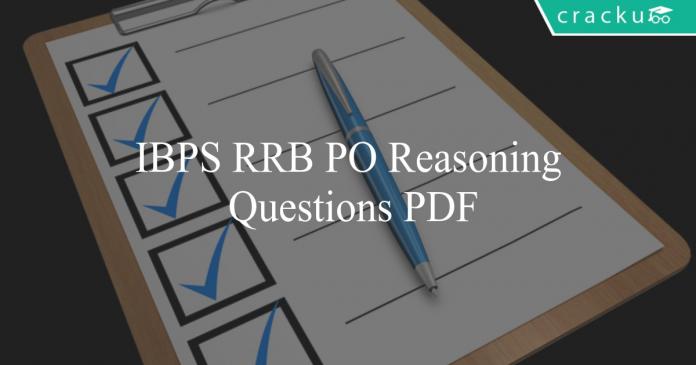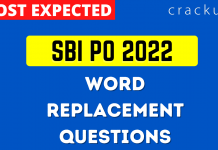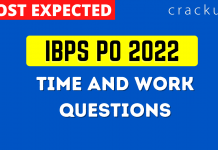IBPS RRB PO Reasoning Questions PDF
Download Top-20 IBPS RRB PO Reasoning Questions PDF. Reasoning questions based on asked questions in previous year exam papers very important for the IBPS RRB PO (Officer Scale-I, II & III) exam.
Download IBPS RRB PO Reasoning Questions PDF
35 IBPS RRB PO Mocks @ Rs. 199. Enroll Now
Question 1: In the following question, select the related letters from the given alternatives.
GAFT : PJOC :: WORS : ?
a) FXBA
b) FAXB
c) FXAB
d) FXJB
Question 2: Find the option that should replace the (?) so that the second pair bears the same relationship as the first pair:
84:48::73: ?
a) 56
b) 16
c) 40
d) 36
e) 46
Question 3: Find the option which should replace (?), so that the second pair shares the same relation as the first pair.
$4 : 272 : 2 : ?$
a) 12
b) 135
c) 138
d) 20
e) 124
Question 4: Trumpet: Elephant :: Purr: ……
a) dog
b) tiger
c) antelope
d) cat
Question 5: An embryo is related to a new-born in the same way as ………………..
a) an egg is related to a chick
b) a student is related to a teacher
c) an old man is related to a young man
d) a lion is related to a lioness
Question 6: 1992 : 996 :: ? : 448
a) 894
b) 786
c) 224
d) 896
Free Mock Test for IBPS RRB PO
IBPS RRB Clerk Previous Papers
Question 7: In a certain encryption “CARDIAC” is coded as “ACRDICA”. How is “READER” coded in the same encryotion?
a) REARED
b) REDAER
c) ERDEAR
d) ERADRE
Question 8: In a certain encryption, “PETALS” is coded as “UJYFQX”. How is “MASTER” coded in the same encryption?
a) GYKHTG
b) PJGEGH
c) USJAKIL
d) RFXYJW
Question 9: 7 : 51 :: 5 : ?
a) 23
b) 24
c) 25
d) 27
Question 10: ‘Music’ is related to ‘Notes’ in the same way as ‘Language’ is related to………………
a) Sentences
b) Combination
c) Grammar
d) Alphabets
e) Syntax
Instructions
Study the following information and answer the questions given below.
If,
A # B means A is father of B
A & B means A is husband of B
A @ B means A is sister of B
A % B means A is daughter of B
Question 11: Which of the following should replace question mark (?) such that P is son-in-law of T?
P & Q (?) R & S @ T
a) %
b) @
c) &
d) #
e) Either A or B
Question 12: Which of the following shows that E is sister-in-law of A?
a) A & B @ C % F @ D & E
b) A @ B & C % D @ E & F
c) A & B % C # D @ E % F
d) More than one of the options above
e) None of these
Question 13: How is M related to R in M @ N # O % P @ R?
a) Sister
b) Sister-in-law
c) Niece
d) Cousin
e) Can’t be determined
Question 14: How is T related to P in P & Q @ R # S @ T?
a) Son-in-law
b) Nephew
c) Daughter-in-law
d) Niece
e) Can’t be determined
Question 15: How is A related to D in A # B @ C & D % E?
a) Son-in-law
b) Nephew
c) Father-in-law
d) Uncle
e) Can’t be determined
Quantitative Aptitude formulas PDF
520 Banking Mocks – Just Rs. 499
Instructions
8 colleagues (A,B,C,D,E,F,G,H) are sitting around a rectangular table and facing in opposite direction alternatively. Four of the colleagues are sitting on the corners and four of them are sitting on the edges of the table. Each of the colleague belongs to Mumbai, New Delhi, Chennai, Kolkata, Hyderabad, Jaipur, Indore and Chandigarh (not in that order). The cities Mumbai, New Delhi, Kolkata and Chennai are called metros. It is also known that :
Everyone sitting at the corner faces towards the table. People from metros do not sit opposite each other. H sits in a corner opposite the person from New Delhi. The person sitting third to the right of A who is from Chennai, is from New Delhi. B from Chandigarh sits opposite to F from Kolkata and they both face each other. C from Indore sits third to the left of H, who is from Jaipur. G sits opposite to the person from Indore and is second to the right of E who is from Hyderabad. D faces the table.
Question 16: Which amongst the following does not face the table ?
a) The person from New Delhi
b) The person from Kolkata
c) The person from Mumbai
d) The person from Chandigarh
e) Cannot be determined
Question 17: Who sits left of the person from Chennai ?
a) C
b) H
c) G
d) A
e) Cannot be determined
Question 18: Who sits second to the right of the person who sits opposite C ?
a) The person from New Delhi
b) The person from Chennai
c) The person from Mumbai
d) The person from Kolkata
e) Cannot be determined
Question 19: Who sits right of the person sitting opposite to the person from Indore ?
a) H
b) G
c) B
d) C
e) Cannot be determined
Question 20: Who faces H ?
a) A
b) G
c) H
d) D
e) Cannot be determined
18000 Free Solved Questions – Banking Study Material
35 IBPS RRB PO Mocks @ Rs. 199. Enroll Now
Answers & Solutions:
1) Answer (C)
The logic followed here is (n + 9). Hence, the code for GAFT will be,
G + 9 = P, A + 9 =J, F + 9 = O, T + 9 = C.
Similarly, the code for WORS is,
W + 9 = F, O + 9 = X, R + 9 = A, S + 9 = B.
Hence, option C is the correct answer.
2) Answer (C)
$84 = 8^2 – 4^2 = 64 – 16 = 48$
Using the same logic,
$73 = 7^2 – 3^2 = 49 – 9 = 40$.
Therefore, option C is the right answer.
3) Answer (D)
The given numbers follow the following relation:
$4 : 4^2 + 4^4$
$2 : 2^2 + 2^4$
Hence, 20 is the correct answer.
4) Answer (D)
Trumpet is the sound made by Elephant. Purr is the sound made by a cat.
5) Answer (A)
An embryo is represents a fertilized fetus before birth. An egg is similar to a fetus and a chick represents a new born.
6) Answer (D)
996 = 1992/2
So, the required number = 448*2 = 896
7) Answer (D)
The first two and the last two letters are interchanged keeping other letters the same.
8) Answer (D)
Every letter in PETALS is replaced by a letter that is 5 places ahead in the English alphabetical series.
9) Answer (D)
51 = $7^2$ + 2
So, the required number is $5^2$ + 2 = 27
10) Answer (A)
Music is composed from notes, similarly a language is made from sentences.
=> Ans – (A)
11) Answer (A)
By putting % in the blank,
P & Q → P is husband of Q
Q % R → Q is daughter of R
R & S → R is husband of S
S @ T → s is sister of T.
Here, P is husband of Q who is niece of T.
Hence, P is son-in-law of T.
12) Answer (C)
By checking Option C,
A & B → A is husband of B
B % C → B is daughter of C
C # D → C is father of D
D @ E → D is sister of E
E % F → E is daughter of F
Here, E is sister of B who is A’s wife.
Hence, E is sister-in-law of A.
13) Answer (B)
M @ N → M is sister of N
N # O → N is father of O
O % P → O is daughter of P
P @ R → P is sister of R
Here, M is brother-in-law’s sister of R.
Hence, M is sister-in-law of R.
14) Answer (E)
P & Q → P is husband of Q
Q @ R → Q is sister of R
R # S → R is father of S
S @ T → S is sister of T.
Here, The gender of T is unknown.
Hence, T can be either son-in-law or daughter-in-law of P.
15) Answer (C)
A # B → A is father of B
B @ C → B is sister of C
C & D → C is husband of D
D % E → D is daughter of E
Here, A is father of D’s husband.
Hence, A is father-in-law of D.
16) Answer (C)
Let us assign H a corner and work our way from there. The person sitting opposite to H is from New Delhi. This means that H cannot be from a metro. The person sitting third to the right of A who is from Chennai, is from New Delhi which means that the person sitting third to the right of the person from New Delhi is A from Chennai. Now the arrangement will look like this :

H is from Jaipur and person sitting third to the left of H is from Indore. G sits opposite to the person from Indore. The person from Hyderabad is second to the right of G. Now the arrangement will look like this :

B from Chandigarh and F from Kolkata face each other which means that they must sit on the corners. This means that G is from Mumbai as one out of pair of people sitting opposite to each other is from a metro. We also know that the person from Indore is C. Since D faces the table, we know that D is sitting on one of the corners. Since only one corner is left, we know that D is the person from New Delhi. This also means that the person from Hyderabad is E. Now the arrangement will look like this :

From the figure, we can see that from the given options, G the person from Mumbai does not face the table.
17) Answer (B)
Let us assign H a corner and work our way from there. The person sitting opposite to H is from New Delhi. This means that H cannot be from a metro. The person sitting third to the right of A who is from Chennai, is from New Delhi which means that the person sitting third to the right of the person from New Delhi is A from Chennai. Now the arrangement will look like this :

H is from Jaipur and person sitting third to the left of H is from Indore. G sits opposite to the person from Indore. The person from Hyderabad is second to the right of G. Now the arrangement will look like this :

B from Chandigarh and F from Kolkata face each other which means that they must sit on the corners. This means that G is from Mumbai as one out of pair of people sitting opposite to each other is from a metro. We also know that the person from Indore is C. Since D faces the table, we know that D is sitting on one of the corners. Since only one corner is left, we know that D is the person from New Delhi. This also means that the person from Hyderabad is E. Now the arrangement will look like this :

From the figure, A is from Chennai who faces away from the table. Thus, H from Jaipur is left of A.
18) Answer (B)
Let us assign H a corner and work our way from there. The person sitting opposite to H is from New Delhi. This means that H cannot be from a metro. The person sitting third to the right of A who is from Chennai, is from New Delhi which means that the person sitting third to the right of the person from New Delhi is A from Chennai. Now the arrangement will look like this :

H is from Jaipur and person sitting third to the left of H is from Indore. G sits opposite to the person from Indore. The person from Hyderabad is second to the right of G. Now the arrangement will look like this :

B from Chandigarh and F from Kolkata face each other which means that they must sit on the corners. This means that G is from Mumbai as one out of pair of people sitting opposite to each other is from a metro. We also know that the person from Indore is C. Since D faces the table, we know that D is sitting on one of the corners. Since only one corner is left, we know that D is the person from New Delhi. This also means that the person from Hyderabad is E. Now the arrangement will look like this :

From the figure, we can see that the person sitting opposite to C is G who faces away from the table. The person sitting second to the right of G is A who is from Chennai.
19) Answer (A)
Let us assign H a corner and work our way from there. The person sitting opposite to H is from New Delhi. This means that H cannot be from a metro. The person sitting third to the right of A who is from Chennai, is from New Delhi which means that the person sitting third to the right of the person from New Delhi is A from Chennai. Now the arrangement will look like this :

H is from Jaipur and person sitting third to the left of H is from Indore. G sits opposite to the person from Indore. The person from Hyderabad is second to the right of G. Now the arrangement will look like this :

B from Chandigarh and F from Kolkata face each other which means that they must sit on the corners. This means that G is from Mumbai as one out of pair of people sitting opposite to each other is from a metro. We also know that the person from Indore is C. Since D faces the table, we know that D is sitting on one of the corners. Since only one corner is left, we know that D is the person from New Delhi. This also means that the person from Hyderabad is E. Now the arrangement will look like this :

From the figure, we know that the person sitting opposite to C (who is from Indore) is G from Mumbai. The person right to G is H from Jaipur as G is facing away from the table.
20) Answer (D)
Let us assign H a corner and work our way from there. The person sitting opposite to H is from New Delhi. This means that H cannot be from a metro. The person sitting third to the right of A who is from Chennai, is from New Delhi which means that the person sitting third to the right of the person from New Delhi is A from Chennai. Now the arrangement will look like this :

H is from Jaipur and person sitting third to the left of H is from Indore. G sits opposite to the person from Indore. The person from Hyderabad is second to the right of G. Now the arrangement will look like this :

B from Chandigarh and F from Kolkata face each other which means that they must sit on the corners. This means that G is from Mumbai as one out of pair of people sitting opposite to each other is from a metro. We also know that the person from Indore is C. Since D faces the table, we know that D is sitting on one of the corners. Since only one corner is left, we know that D is the person from New Delhi. This also means that the person from Hyderabad is E. Now the arrangement will look like this :

From the figure, we know that the person facing H is D.



![SBI PO Puzzles Questions PDF [Most Important] _ Puzzles Questions](https://cracku.in/blog/wp-content/uploads/2022/10/Puzzles-Questions--218x150.png)

